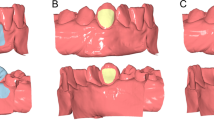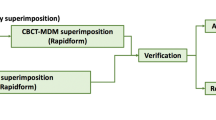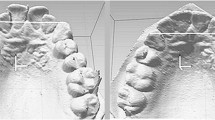Abstract
Objectives
The statistical shape model (SSM) is a model of geometric properties of a set of shapes based on statistical shape analysis. The SSM develops an average model of several objects using an automated algorithm that excludes the operator’s subjectivity. The aim of this study was to develop a three-dimensional (3D) SSM of normal dentition to provide virtual templates for efficient treatment.
Materials and methods
Dental casts were obtained from participants with normal dentition. After acquiring the 3D models, the SSMs of the individual teeth and whole dental arch were generated by an iterative closest point (ICP)-based rigid registration and point correspondences, respectively. Then, the individual tooth SSM was aligned to the whole dental arch SSM using ICP-based registration to generate an average model of normal dentition.
Results
The generated 3D SSM showed specific morphological features of normal dentition similar to those previously reported. Moreover, on measuring the arch dimensions, all values in this study were similar to those previously reported using normal dentition.
Conclusions
The 3D SSM of normal dentition may increase the diagnostic efficiency of orthodontic treatments by providing a visual objective. It can be also used as a 3D template in various fields of dentistry.
Clinical relevance
Our SSM of normal dentition provides both quantitative and qualitative information on the 3D morphology of teeth and dental arches, which may provide valuable information on 3D virtual-setup, bracket fabrication, and aligner treatment.












Similar content being viewed by others
References
Davis PV, Bradley JG (1996) The meaning of normal. Perspect Biol Med 40:68–77. https://doi.org/10.1353/pbm.1996.0001
Stanford ND, Ip TB, Durham J (2014) Adult orthodontic patients’ views regarding dentofacial normality: a qualitative study. Am J Orthod Dentofac Orthop 145:287–295. https://doi.org/10.1016/j.ajodo.2013.11.016
Hassan R, Rahimah Ak (2007) Occlusion, malocclusion and method of measurements — an overview. Archives of Orofacial Sci 2:3–9
Andrews LF (1972) The six keys to normal occlusion. Am J Orthod 62:296–309. https://doi.org/10.1016/s0002-9416(72)90268-0
Roth RH (1987) The straight-wire appliance 17 years later. J Clin Orthod 21:632–642
McLaughlin RP, Bennett JC (1995) Bracket placement with the preadjusted appliance. J Clin Orthod 29:302–311
Burns A, Dowling AH, Garvey TM, Fleming GJ (2014) The reliability of Little’s irregularity index for the upper dental arch using three dimensional (3D) digital models. J Dent 42:1320–1326. https://doi.org/10.1016/j.jdent.2014.07.012
Lombardo L, Perri A, Arreghini A, Latini M, Siciliani G (2015) Three-dimensional assessment of teeth first-, second- and third-order position in Caucasian and African subjects with ideal occlusion. Prog Orthod 16:11. https://doi.org/10.1186/s40510-015-0086-9
Tong H, Kwon D, Shi J, Sakai N, Enciso R, Sameshima GT (2012) Mesiodistal angulation and faciolingual inclination of each whole tooth in 3-dimensional space in patients with near-normal occlusion. Am J Orthod Dentofacial Orthop 141:604–617. https://doi.org/10.1016/j.ajodo.2011.12.018
Kannabiran P, Thirukonda GJ, Mahendra L (2012) The crown angulations and inclinations in Dravidian population with normal occlusion. Indian J Dent Res 23:53–58. https://doi.org/10.4103/0970-9290.99039
Andrews LF (1989) Straight wire: the concept and appliance. L.A. Wells, Michigan
Shin-Jae L, Sug-Joon A, Tae-Woo K (2005) Clinical crown angulation and inclination of normal occlusion in a large Korean sample. Korean J Orthod 35:331–340
Young-Il C, Won-Sik Y, Dong-Seok N, Seong-cheol M (2000) A study for the development of the Korean orthodontic bracket. Korean J Orthod 30:565–578
Young-Chel P (1991) A morphologic study on straight wire bracket for Korean. Korean J Orthod 21:481–493
HuancaGhislanzoni L, Lione R, Cozza P, Franchi L (2017) Measuring 3D shape in orthodontics through geometric morphometrics. Prog Orthod 18:38. https://doi.org/10.1186/s40510-017-0194-9
Ambellan F, Lamecker H, von Tycowicz C, Zachow S (2019) Statistical shape models: understanding and mastering variation in anatomy. Adv Exp Med Biol 1156:67–84. https://doi.org/10.1007/978-3-030-19385-0_5
Heimann T, Meinzer HP (2009) Statistical shape models for 3D medical image segmentation: a review. Med Image Anal 13:543–563. https://doi.org/10.1016/j.media.2009.05.004
Jie B, Han B, Yao B, Zhang Y, Liao H, He Y (2022) Automatic virtual reconstruction of maxillofacial bone defects assisted by ICP (iterative closest point) algorithm and normal people database. Clin Oral Investig 26:2005–2014. https://doi.org/10.1007/s00784-021-04181-3
Zachow S, Lamecker H, Elsholtz B, Stiller M (2005) Reconstruction of mandibular dysplasia using a statistical 3D shape model. Int Congr Ser 1281:1238–1243. https://doi.org/10.1016/j.ics.2005.03.339
Wu T, Liao W, Dai N (2012) Three-dimensional statistical model for gingival contour reconstruction. IEEE T Biomed Eng 59:1086–1093. https://doi.org/10.1109/tbme.2012.2183368
Abdolali F, Zoroofi RA, Abdolali M, Yokota F, Otake Y, Sato Y (2017) Automatic segmentation of mandibular canal in cone beam CT images using conditional statistical shape model and fast marching. Int J Comput Assist Radiol Surg 12:581–593. https://doi.org/10.1007/s11548-016-1484-2
Nanda V, Gutman B, Bar E, Alghamdi S, Tetradis S, Lusis AJ, Eskin E, Moon W (2015) Quantitative analysis of 3-dimensional facial soft tissue photographic images: technical methods and clinical application. Prog Orthod 16:21. https://doi.org/10.1186/s40510-015-0082-0
Shin SM, Kim YM, Kim NR, Choi YS, Park SB, Kim YI (2016) Statistical shape analysis-based determination of optimal midsagittal reference plane for evaluation of facial asymmetry. Am J Orthod Dentofac Orthop 150:252–260. https://doi.org/10.1016/j.ajodo.2016.01.017
Nauwelaers N, Matthews H, Fan Y, Croquet B, Hoskens H, Mahdi S, El Sergani A, Gong S, Xu T, Bronstein M, Marazita M, Weinberg S, Claes P (2021) Exploring palatal and dental shape variation with 3D shape analysis and geometric deep learning. Orthod Craniofac Res 24:134–143. https://doi.org/10.1111/ocr.12521
Heikinheimo K, Nyström M, Heikinheimo T, Pirttiniemi P, Pirinen S (2012) Dental arch width, overbite, and overjet in a Finnish population with normal occlusion between the ages of 7 and 32 years. Eur J Orthod 34:418–426. https://doi.org/10.1093/ejo/cjr025
Hugoson A, Bergendal T, Ekfeldt A, Helkimo M (1988) Prevalence and severity of incisal and occlusal tooth wear in an adult Swedish population. Acta Odontol Scand 46:255–265. https://doi.org/10.3109/00016358809004775
Richardson ER (1980) Racial differences in dimensional traits of the human face. Angle Orthod 50:301–311. https://doi.org/10.1043/0003-3219(1980)050%3C0301:rdidto%3E2.0.co;2
Lombardo L, Coppola P, Siciliani G (2015) Comparison of dental and alveolar arch forms between different ethnic groups. Int Orthod 13:462–488. https://doi.org/10.3109/00016358809004775
Lavelle CL (1978) A metrical study of dental arch form. J Dent 6:120–124. https://doi.org/10.1016/0300-5712(78)90208-7
Oliva B, Sferra S, Greco AL, Valente F, Grippaudo C (2018) Three-dimensional analysis of dental arch forms in Italian population. Prog Orthod 19:34. https://doi.org/10.1186/s40510-018-0233-1
Raberin M, Laumon B, Martin JL, Brunner F (1993) Dimensions and form of dental arches in subjects with normal occlusions. Am J Orthod Dentofacial Orthop 104:67–72. https://doi.org/10.1016/0889-5406(93)70029-n
Fernandes LQP, Nunes LKF, Alves LS, Ribeiro FAC, Capelli JJ (2017) Three-dimensional evaluation of mandibular anterior dental crowding in digital dental casts. Dental Press J Orthod 22:64–71. https://doi.org/10.1590/2177-6709.22.3.064-071.oar
Manu (2015) Shape Model builder. MATLAB Central File Exchange. https://www.mathworks.com/matlabcentral/fileexchange/49940-shape-model-builder. Accessed October 16, 2022
Segal A, Haehnel D (2009) Thrun S 2009 Generalized-icp. In Robotics: Sci Syst 2(4):435
Esat II, Bahai H (2000) Surface alignment based on the moment of inertia and improved least-squares methods. P I Mech Eng B-J Eng 214:547–554. https://doi.org/10.1243/0954405001518242
Besl PJ, McKay ND (1992) A method for registration of 3-D shapes. IEEE T Pattern Anal 14:239–256. https://doi.org/10.1109/34.121791
Audenaert EA, Van Houcke J, Almeida DF, Paelinck L, Peiffer M, Steenackers G, Vandermeulen D (2019) Cascaded statistical shape model based segmentation of the full lower limb in CT. Comput Method Biomec 22:644–657. https://doi.org/10.1080/10255842.2019.1577828
Li H, Sumner RW, Pauly M (2008) Global correspondence optimization for non-rigid registration of depth scans. Comput Graph Forum 27:1421–1430. https://doi.org/10.1111/j.1467-8659.2008.01282.x
Carr JC, Beatson RK, Cherrie JB, Mitchell TJ, Fright WR, McCallum BC, Evans TR (2001) Reconstruction and representation of 3D objects with radial basis functions. P ACM CGIT:67–76 https://doi.org/10.1145/383259.383266
Chui H, Rangarajan A (2003) A new point matching algorithm for non-rigid registration. Comput Vis Image Underst 89:114–141. https://doi.org/10.1016/S1077-3142(03)00009-2
de Boer A, van der Schoot MS, Bijl H (2007) Mesh deformation based on radial basis function interpolation. Comput Struct 85:784–795. https://doi.org/10.1016/j.compstruc.2007.01.013
Kim Y, Na YH, Xing L, Lee R, Park S (2016) Automatic deformable surface registration for medical applications by radial basis function-based robust point-matching. Comput Biol Med 77:173–181. https://doi.org/10.1016/j.compbiomed.2016.07.013
Cootes TF, Taylor CJ, Cooper DH, Graham J (1995) Active shape models-their training and application. Comput Vis Image Underst 61:38–59. https://doi.org/10.1006/cviu.1995.1004
de Bruijne M, van Ginneken B, Viergever MA, Niessen WJ (2003) Adapting Active Shape Models for 3D segmentation of tubular structures in medical images. Inf Process Med Imaging 18:136–147. https://doi.org/10.1007/978-3-540-45087-0_12
Park SJ, Leesungbok R, Song JW, Chang SH, Lee SW, Ahn SJ (2017) Analysis of dimensions and shapes of maxillary and mandibular dental arch in Korean young adults. J Adv Prosthodont 9:321–327. https://doi.org/10.4047/jap.2017.9.5.321
Uysal T, Usumez S, Memili B, Sari Z (2005) Dental and alveolar arch widths in normal occlusion and Class III malocclusion. Angle Orthod 75:809–813. https://doi.org/10.1043/0003-3219(2005)75[809:DAAAWI]2.0.CO;2
Bruse JL, McLeod K, Biglino G, Ntsinjana HN, Capelli C, Hsia TY, Sermesant M, Pennec X, Taylor AM, Schievano S (2016) A statistical shape modelling framework to extract 3D shape biomarkers from medical imaging data: assessing arch morphology of repaired coarctation of the aorta. BMC Med Imaging 16:40. https://doi.org/10.1186/s12880-016-0142-z
Alimohamadi Gilakjan S, Majedi H, Makki Abadi B, Ahmadian A (2020) Spinal pain relief procedures with the assistance of the MRI-updated statistical shape model. Int J Med Robot 16:e2085. https://doi.org/10.1002/rcs.2085
Nam SE, Kim YH, Park YS, Baek SH, Hayashi K, Kim KN, Lee SP (2012) Three-dimensional dental model constructed from an average dental form. Am J Orthod Dentofacial Orthop 141:213–218. https://doi.org/10.1016/j.ajodo.2011.06.038
Jung Jin Y, Byung Wha S (1986) A study of the crown angulation in normal occlusion. Korean J Orthod 16:123–133
Kim JY, Lee SJ, Kim TW, Nahm DS, Chang YI (2005) Classification of the skeletal variation in normal occlusion. Angle Orthod 75:311–319. https://doi.org/10.1043/0003-3219(2005)75[311:cotsvi]2.0.co;2
Lee SJ, Lee S, Lim J, Park HJ, Wheeler TT (2011) Method to classify dental arch forms. Am J Orthod Dentofacial Orthop 140:87–96. https://doi.org/10.1016/j.ajodo.2011.03.016
Funding
This work was supported by the Korea Medical Device Development Fund grant funded by the Korea Government, the Ministry of Science and ICT (#202012E09), the Ministry of Trade, Industry and Energy (#202011B05).
Author information
Authors and Affiliations
Contributions
SJA conceived the study; SJA, WJY, and YIC contributed to the design and methodological variables; WHK and SC performed the experiments; WHK, SC, WJY, and SJA interpreted the data; WHK, SC, WJY, and SJA contributed to the writing of the manuscript; WHK, SC, YIC, WJY, and SJA read and edited the manuscript; and all authors read and approved the final version of the manuscript.
Corresponding author
Ethics declarations
Ethics approval
This retrospective chart review study involving human participants was in accordance with the ethical standards of the institutional and national research committee and with the 1964 Helsinki Declaration and its later amendments or comparable ethical standards. The institutional review board of the University approved the research protocol as mentioned in the manuscript (S-020190008).
Conflict of interest
The authors declare no competing interests.
Additional information
Publisher's note
Springer Nature remains neutral with regard to jurisdictional claims in published maps and institutional affiliations.
Rights and permissions
Springer Nature or its licensor (e.g. a society or other partner) holds exclusive rights to this article under a publishing agreement with the author(s) or other rightsholder(s); author self-archiving of the accepted manuscript version of this article is solely governed by the terms of such publishing agreement and applicable law.
About this article
Cite this article
Kim, HH., Choi, S., Chang, YI. et al. Developing a three-dimensional statistical shape model of normal dentition using an automated algorithm and normal samples. Clin Oral Invest 27, 759–772 (2023). https://doi.org/10.1007/s00784-022-04824-z
Received:
Accepted:
Published:
Issue Date:
DOI: https://doi.org/10.1007/s00784-022-04824-z




